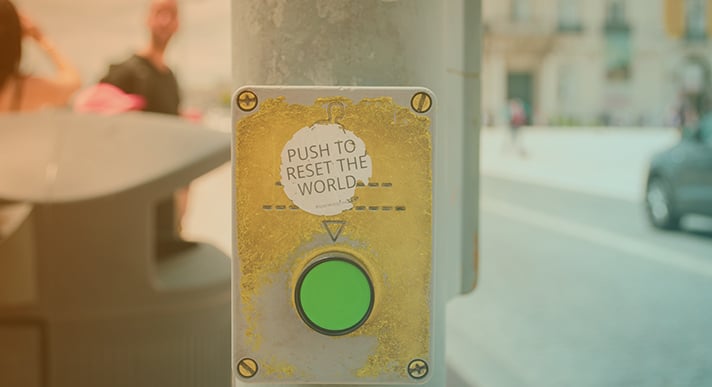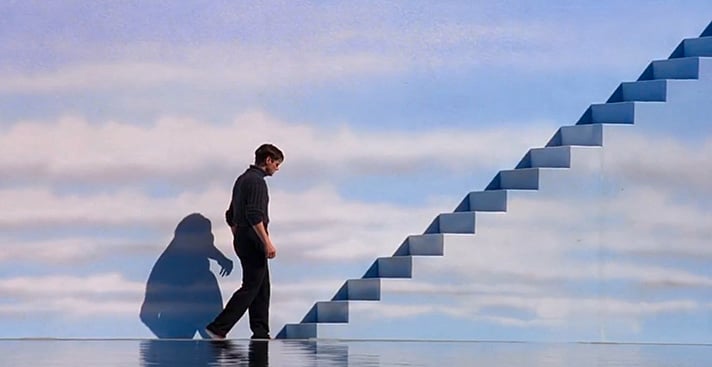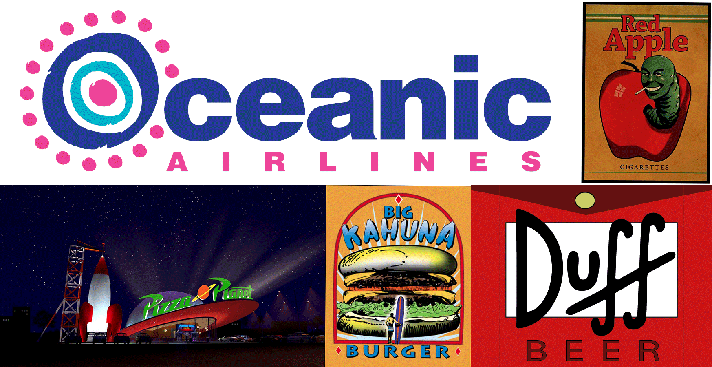
Firstly, I need to address that the research for this post and the topic of the post, might just make this my favourite piece of work that I’ve ever written. For those that don’t know me, I’m a big movie fan, so taking one of my favourite pastimes and mixing that with my favourite aspect of marketing was a no brainer. Ladies and gentlemen, I present to you the Top 5 Fictional Brands.
Before you go ahead, you may want to read up on my article about ‘Writing Brand Guidelines’ and you may be wondering what factors I’ve considered when judging these fictional brands. Well I’ve taken into account factors such as logo design, merchandise design, plausibility, real world integration and finally, how good the movie/TV show is. (I tried to keep the final factor to as much of a minimum as possible).
So, let’s get straight into it…
Red Apple Cigarettes
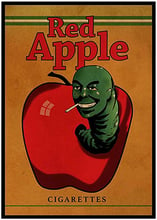 You may only be coming across Red Apple Cigarettes for the first time here, and that’s part of why it made the list as there’s a very high chance you’ve seen a film where this is referenced, but it’s subtlety means that it blends in to its fictional universe wonderfully.
You may only be coming across Red Apple Cigarettes for the first time here, and that’s part of why it made the list as there’s a very high chance you’ve seen a film where this is referenced, but it’s subtlety means that it blends in to its fictional universe wonderfully.
Red Apple is part of the Tarantino Universe (and if you haven’t put together how all of Tarantino’s films exist within the same universe- there’s plenty of places online for that), making its debut in Pulp Fiction. It’s also seen in Kill Bill, Inglorious Basterds, The Hateful Eight and Once Upon A Time in Hollywood.
Now what is it about Red Apple that makes this work so well? Partly it’s my appreciation for Tarantino films, granted, but really there are some fascinating aspects here. The logo depicts a healthy looking red apple, with a worm revealing itself from the inside of the apple – that is likely a metaphor for lung cancer. The colours are complimentary and it feels very much like cigarette packaging.
Like any good brand, it needs to be recognisable and with a slogan of ‘Better drag, more flavour, less throat burn’ it feels like the real deal.
What’s most impressive however, is the consistency of image – in The Hateful Eight the packaging features a more vintage design – better keeping with the times. In Once Upon A Time In Hollywood, Rick Dalton (Leo DiCaprio) stars in a TV advert for the brand – of course the once famous movie star, Rick Dalton, would be the ideal person to advertise cigarettes on the TV in the ‘70s. All in all, everything feels on brand and is consistent throughout each appearance.
Big Kahuna Burger
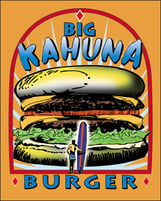 This might be more familiar, another Tarantino reference, which believe me, I was hesitant to do, but due to the famous nature of the scene this is in, it had to be included. Big Kahuna Burger is a chain of Hawaiian themed fast food restaurants appearing in many Tarantino films.
This might be more familiar, another Tarantino reference, which believe me, I was hesitant to do, but due to the famous nature of the scene this is in, it had to be included. Big Kahuna Burger is a chain of Hawaiian themed fast food restaurants appearing in many Tarantino films.
Again, the logo design here is superb, what says ‘Hawaiian burger joint’ more than a logo with a gigantic burger and a surfer?
Part of the success here is the infamous scene in Pulp Fiction with Samuel L Jackson and John Travolta, however Tarantino has used this in movies both before and after Pulp Fiction. His debut movie Reservoir Dogs features Mr Blonde drinking a soda from Big Kahuna Burger.
Pizza Planet
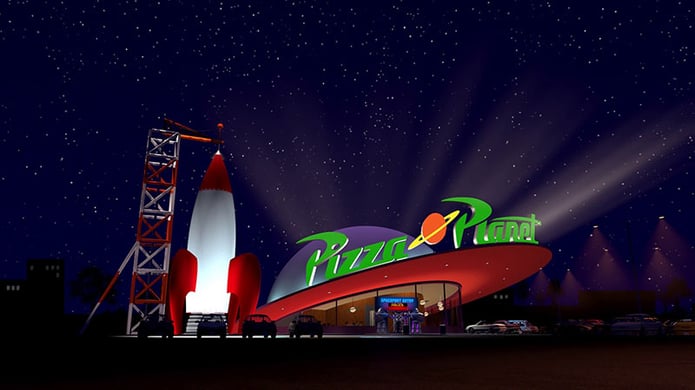 The first non Tarantino reference here, and a slight change of pace. Pizza Planet – you’re likely familiar with this from the Toy Story franchise.
The first non Tarantino reference here, and a slight change of pace. Pizza Planet – you’re likely familiar with this from the Toy Story franchise.
Pizza Planet is quite clearly aimed at children and it fits into the world presented to us in Toy Story. It makes sense, kids like Pizza and kids like aliens. So create a planet full of aliens and serve the kids Pizza. How is this further embedded? Well the Pizza Planet locations offer more than just takeaway food, they offer slime dispensers, Whack-a-Alien game, and of course ‘The Claw’ where kids can win adorable toys.
The restaurant design works, it depicts, you guessed it, a planet! It’s easy to imagine every child in the region desperately wanting birthday parties here, or even just a weekly visit.
The brand is easy to make merchandise for, in Toy Story you can see a wall chart in Andy’s bedroom, the Pizza Planet truck (found in many Pixar films) and of course the toy aliens. All of this lends itself to immersing the brand into the daily life of its audience – and that’s something only the strongest brands can achieve.
Duff Beer
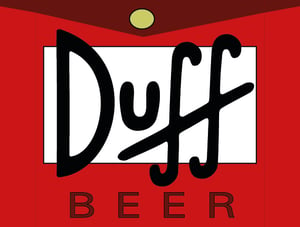 Surely this inclusion needs no introduction? But for those who have never come across Duff, it’s Homer Simpson’s favourite beer. You can probably tell from the name that this is satire on mass-produced beer popular amongst many Americans. The beer is incredibly marketed within the show, its mascot Duffman, Duff Gardens theme park and of course the Duff blimp are just a few of the ways in which the brand shows it’s expansion and influence on the daily lives of those in and around Springfield.
Surely this inclusion needs no introduction? But for those who have never come across Duff, it’s Homer Simpson’s favourite beer. You can probably tell from the name that this is satire on mass-produced beer popular amongst many Americans. The beer is incredibly marketed within the show, its mascot Duffman, Duff Gardens theme park and of course the Duff blimp are just a few of the ways in which the brand shows it’s expansion and influence on the daily lives of those in and around Springfield.
Not only is it marketed well, but the branding fits the industry and looks extremely close to another real world mass-produced beer company… Let’s just say Duffman was satire of a 1970s Bud Man, and if you’ve never heard of that give yourself a quick search so you can see how far branding techniques really have moved forward.
It’s no real surprise then, that with it’s popularity in the show, real life companies have tried to make this themselves. This process of selling your own goods under another brand name is known as ‘brandjacking’ and that is exactly what has happened with Duff on many occasions, leading to many legal battles.
Oceanic Airlines
 Okay, where to start with this one? I have mixed feelings on this inclusion, I lost (no pun intended) 7 years of my life watching this show, adamant that the ending would be worthwhile my patience and forgiveness of mediocre mid seasons. But no. The ending was very, very bad. However, before I turn this into another 4000 words on why ‘Lost’ absolutely lost me as a fan (sorry, I winced as I wrote that) I’ll get back on topic with Oceanic Airlines.
Okay, where to start with this one? I have mixed feelings on this inclusion, I lost (no pun intended) 7 years of my life watching this show, adamant that the ending would be worthwhile my patience and forgiveness of mediocre mid seasons. But no. The ending was very, very bad. However, before I turn this into another 4000 words on why ‘Lost’ absolutely lost me as a fan (sorry, I winced as I wrote that) I’ll get back on topic with Oceanic Airlines.
So, as I just alluded to, this Airline company is responsible for crashing our beloved Jack, Locke, Kate, Sawyer and many more on the most mysterious island we’ve ever seen. The first thing to point out here is the plausibility of this branding, If I told you tomorrow I was flying to Australia with Oceanic Airlines you probably wouldn’t second guess me, the name superbly fits the industry.
Then we get to the logo design, and much like the show there’s a lot of uncertainty around the bullseye looking design. Is it a bullseye? Is it the Island itself? There have been many fan theories over the years.
However, part of the reason that this brand made this list was its integration into the real world, as advertisement and launch campaigns for Lost viewers could see TV ads, billboards and web adverts too. The ads didn’t present themselves as a fictional company in a TV show, but as a legitimate company- confusing its viewers.
It’s worth noting now that Lost used this tactic a few times, presenting companies such as Hanso Foundation and DHARMA Initiative through similar methods. When a fictional company can brand itself in the real world with such subtlety and authenticity to confuse viewers into believing the brand really exists, well, that is about the best example of good branding that you'll ever see.
And so, there we have it. That’s the five best fictional brands who all manage to use real world branding techniques and immerse themselves in to their fictional worlds with ease, some of which break that fourth wall and have a strong presence in the real world too. It’s tough to choose just five, but I set these five out at the start and didn’t deter from my initial plan. I stayed strong and executed what I intended to share with you, if only the creators of Lost could have done the same…



